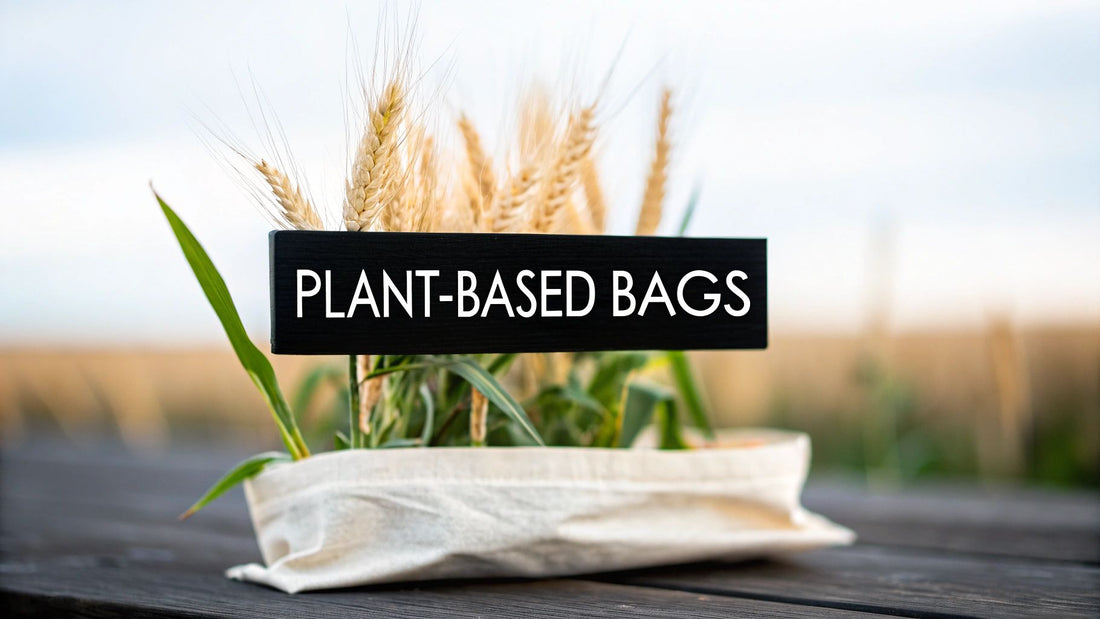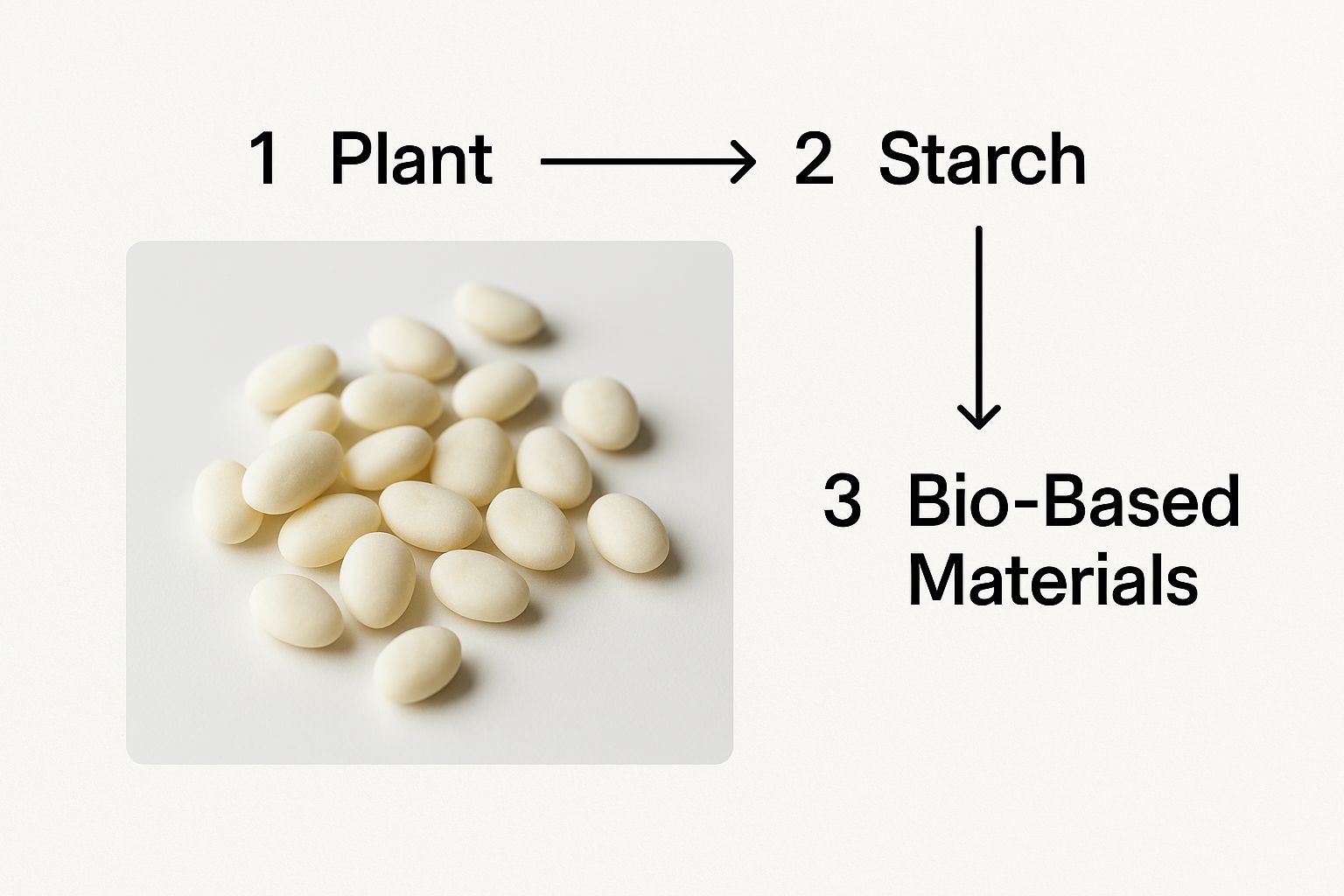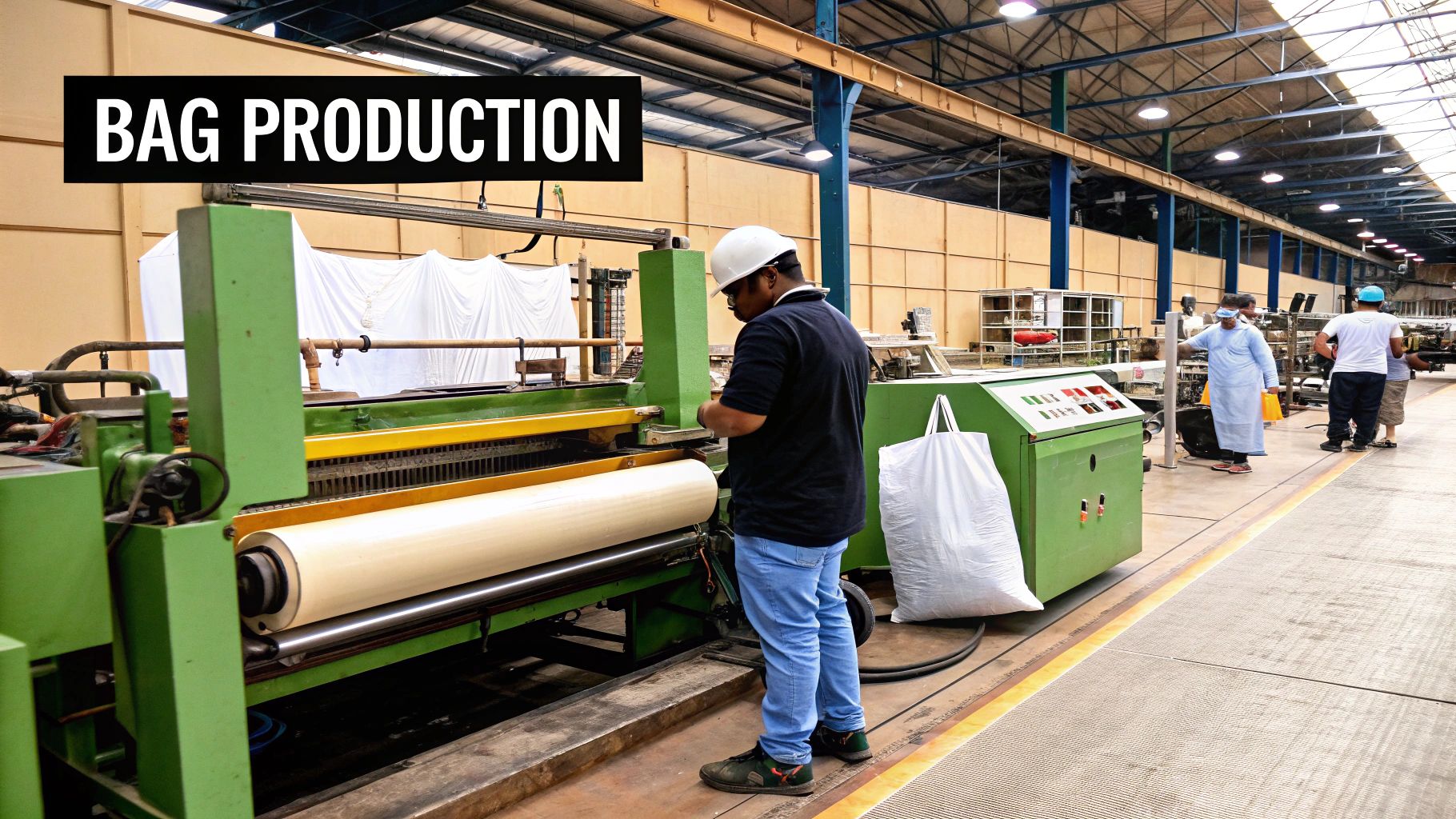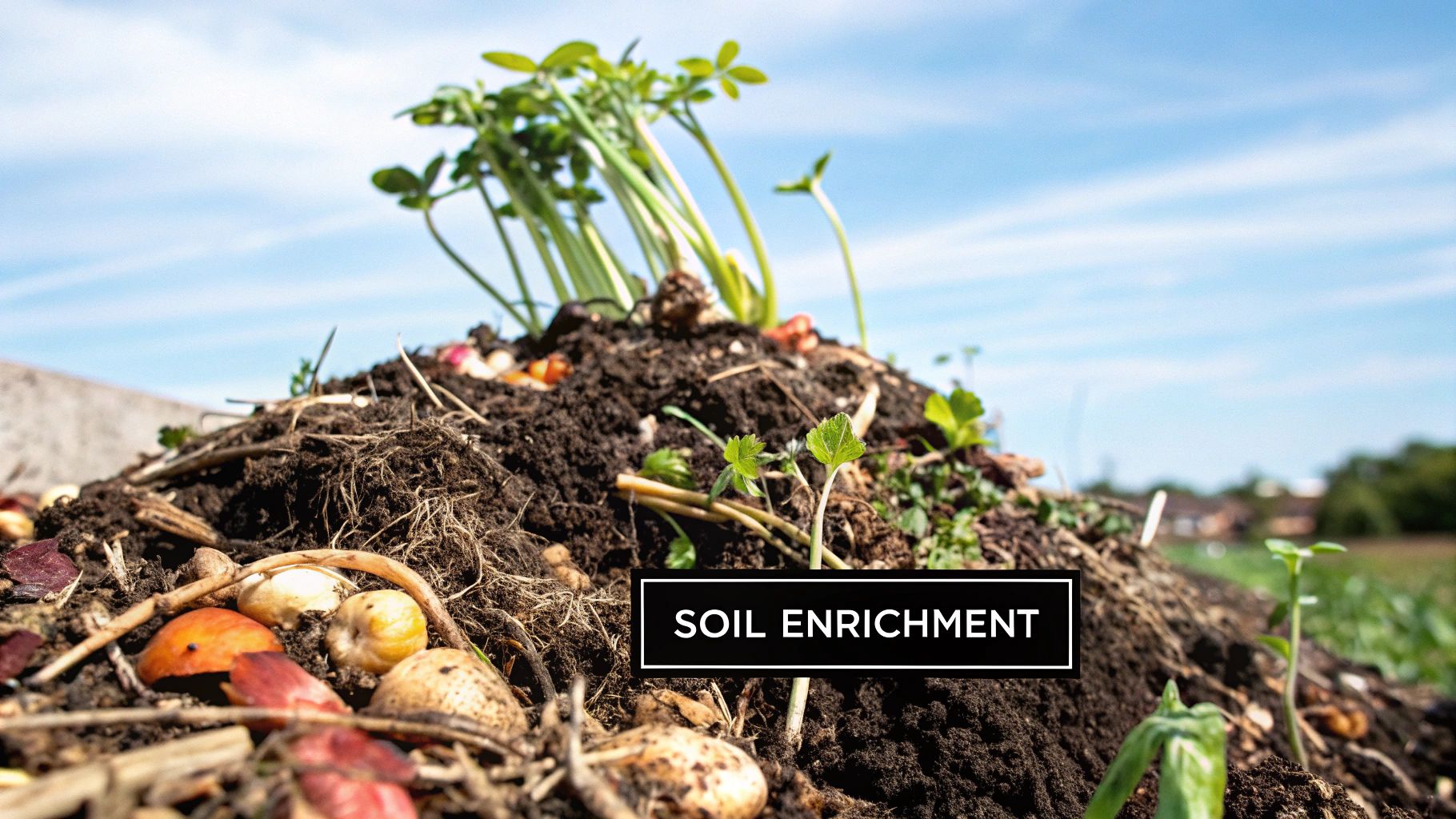
What Are Compostable Bags Made Of? A Guide to the Plant-Based Revolution
Share
Ever wondered what a compostable bag is actually made of? The answer is simple and revolutionary: not the plastic you know.
Forget the fossil fuels and the centuries of pollution. True compostable bags are engineered from a brilliant blend of renewable, plant-based materials and innovative polymers, all designed to break down and return to the earth as nature intended—just like an apple core or a banana peel. This isn't just a better bag; it's a commitment to a healthier planet.
The Real Ingredients Inside a Compostable Bag
Think of a compostable bag as a product engineered by nature, for nature. Its entire lifecycle is designed for a single, noble purpose: to serve you well and then disappear completely back into the soil. To achieve this, manufacturers rely on a precise blend of ingredients, each chosen for a specific role. The result is a bag tough enough for your messiest food scraps, yet gentle enough to decompose without a trace.
So, what’s the secret sauce? The core ingredients are a class of materials called bioplastics. These are plastics derived from renewable, plant-based sources, not petroleum. Let's break down the power players:
- Polylactic Acid (PLA): This is the undisputed workhorse of the compostable world. Crafted by fermenting plant sugars from crops like corn and sugarcane, PLA provides the essential strength and structure of the bag.
- Corn Starch: Exactly what it sounds like—a natural polymer harvested directly from corn. It is a fundamental component that ensures the bag breaks down organically and safely.
- Polybutylene Adipate Terephthalate (PBAT): While it's a mouthful, PBAT is a certified biodegradable and compostable polymer that delivers critical flexibility and toughness. It’s the reason your bag won't tear when you stuff it with wet coffee grounds.
The magic is in the mix. PLA on its own is too stiff and brittle for practical use. By blending it with PBAT, the bag gains the essential stretch and durability to perform flawlessly. This intelligent combination is why these bags are the perfect solution for collecting messy food scraps. You can learn more about how to effectively use compostable bags for food waste in our detailed guide.
A Quick Look at What's Inside Your Compostable Bag
To make it crystal clear, here’s a simple breakdown of the core components you'll find in a typical high-performance compostable bag.
| Material | Primary Source | Key Function |
|---|---|---|
| PLA (Polylactic Acid) | Fermented plant sugars (corn, sugarcane) | Provides strength and structure |
| Corn Starch | Corn | Aids in organic decomposition |
| PBAT (Polybutylene Adipate Terephthalate) | Biodegradable synthetic polymer | Adds flexibility and puncture resistance |
Each ingredient plays a vital role, working in concert to create a product that is both functionally superior and environmentally responsible.
In a typical bag, the amount of plant-based material can range from 15% to 85%. The remainder is composed of biodegradable polymers like PBAT, which are essential for performance and are certified to break down completely under composting conditions. Industry data from sources like Grandview Research confirms this blend is standard, guaranteeing the bags meet the strict standards for true compostability.
How a Plant Becomes a Plastic Bag
It may sound like science fiction, but transforming a simple plant into a sturdy, reliable bag is a reality of modern material science. The process begins in a field with a crop like corn, which is packed with natural starches and sugars. These aren't the sugars for your coffee; they are the fundamental building blocks for an entirely new generation of plastic.
The science that makes this possible is polymerization. Imagine you have a massive pile of tiny Lego bricks. Each brick is a small molecule called a monomer. When you snap those bricks together into long, interconnected chains, you create a polymer—the strong, flexible backbone of the finished bag.
From Cornfield to Bioplastic Pellet
The most common material in compostable bags is Polylactic Acid, or PLA. To create it, manufacturers first harvest corn and extract the glucose (a type of sugar) from the kernels.
Next, this glucose undergoes fermentation, a natural process similar to making beer or yogurt. Microorganisms are introduced, and as they consume the sugar, they produce lactic acid as a byproduct. This is the pivotal step where a farm crop is transformed into a chemical powerhouse.

As the image shows, the entire journey starts with these renewable starches. From there, the lactic acid is purified and put through a few chemical reactions that convert it into rings of a molecule called lactide. This is where the real construction begins.
Building the Polymer Chains
With the lactide rings ready, the final stage is to link them all together to create those long PLA polymer chains. This happens inside a reactor, where heat and special catalysts forge strong, stable bonds. The output is a raw bioplastic resin that looks like small, clear, or milky-white pellets.
These pellets are the finished raw material, ready to be shipped to bag manufacturers. They can be melted down, stretched into an ultra-thin film, and then cut and sealed to create the compostable bags you rely on every day.
The Lego Analogy Revisited: Think of the corn sugars as piles of jumbled Lego pieces. The fermentation process sorts them into identical bricks (lactic acid). Polymerization is the act of clicking all those bricks together to build a strong yet flexible structure—your finished bag.
This journey from a plant in a field to a polymer in your hand shows you exactly what compostable bags are made of. They don't just mimic nature; their core structure is built directly from materials grown in the earth. It's brilliant engineering that allows a bag to be strong when you need it, yet designed to break down and return to the soil once its job is done.
Why Compostable Bags Are a Blend of Materials
If compostable bags are made from plants, you might wonder why they aren't 100% plant material. The answer lies in solving a classic engineering challenge: balancing green ideals with real-world performance.
A bag made from a pure bioplastic like PLA would be far too brittle. Imagine trying to stuff it with wet coffee grounds or heavy potato peels—it would likely tear before you even reached the compost bin. That’s not a recipe for success.
To create a bag that is both strong enough for your kitchen and able to break down in a compost pile, manufacturers have to be smarter. They blend different materials together, creating a superior product that works as intended without compromising its core mission: to disappear back into the earth.
Adding Strength and Flexibility
The secret weapon for giving these bags their much-needed durability is often a polymer called Polybutylene Adipate Terephthalate, or PBAT. Its job is simple but crucial: it adds the stretch and puncture resistance that a pure plant-based plastic like PLA lacks.
Think of it like building with rebar. The PLA provides the basic structure and compostability, like concrete, but it’s the PBAT that acts as the flexible steel reinforcement, preventing the whole thing from cracking under pressure. This blend is what allows your bag to handle sharp eggshells and soggy leftovers without splitting.
Crucially, this partnership is designed so that both materials biodegrade together in a compost environment, leaving behind nutrient-rich soil, not microplastics.
The Performance Trade-Off
Creating a bag that performs like traditional plastic—but decomposes like an apple core—requires a very specific recipe. This often means blending renewable, plant-based materials with certified biodegradable polymers that are, for now, derived from fossil fuels.
It's a common misconception that "compostable" means entirely plant-derived. In reality, industry data shows that many top-performing bags on the market contain 15-35% renewable resources. The remaining 65-85% is made up of specialized, oil-based plastics specifically engineered to biodegrade.
This blend is a deliberate, intelligent trade-off. While the industry is always pushing for higher plant-based content, current technology demands this mix to deliver the strength and reliability we all expect. A flimsy bag that fails and creates a mess would defeat the entire purpose. As you compare different options, it helps to see how brands navigate this balance—our guide to the best compostable trash bags breaks this down further.
Ultimately, understanding what’s in a compostable bag means appreciating this thoughtful blend of materials. It’s not just about using plants; it’s about smart science turning those plants into a product that does its job and then vanishes, making your switch to a greener habit both easy and effective.
How We Prove a Bag Comes from Plants
It’s one thing for a package to claim it's made from plants, but how can you be certain? That’s a fair and important question. The proof isn't just clever marketing—it's backed by powerful science that can pinpoint the origin of a bag's raw materials with undeniable accuracy.
The secret lies in a method that distinguishes carbon from a recently living plant versus carbon from ancient fossil fuels. This technique is called radiocarbon dating, or more specifically, Carbon-14 testing. Think of it as a "birth certificate" for every carbon atom.

All living things, from the smallest blade of grass to the largest tree, constantly absorb a naturally occurring radioactive isotope from the atmosphere: Carbon-14 (C-14). As long as an organism is alive, it maintains a steady level of C-14. Once it dies, that C-14 starts to decay at a predictable rate, acting like a slowly fading atomic clock.
The Atomic Birth Certificate
This is where the truth is revealed. Carbon from recently harvested plants, like the corn used to make PLA bioplastics, has a full, fresh measure of C-14. Its atomic "birth certificate" is essentially brand new.
Now, contrast that with the carbon in traditional plastics. It comes from petroleum—fossil fuels formed from organic matter millions of years ago. By the time that ancient carbon is drilled up and turned into plastic, all of its original C-14 has completely decayed. It has zero C-14 left. Its birth certificate is ancient and long expired.
By measuring the amount of C-14 in a finished compostable bag, scientists can calculate its biobased content with incredible accuracy. A higher C-14 level means more of the bag's carbon came directly from modern plants.
This isn't just a lab exercise. It’s the very foundation of the official standards that keep manufacturers honest. It provides undeniable, scientific proof that the materials come from renewable, plant-based sources, cutting through any greenwashing or skepticism.
Chemically, most compostable bags are made from specific polymer blends. These often combine renewable, plant-based carbon with a smaller amount of fossil-fuel-based carbon to achieve the right performance. The exact ratio is verified through standards like ASTM D6866, which uses this exact radiocarbon analysis to tell the two types of carbon apart and certify the bag’s biobased percentage.
This scientific rigor ensures that when you see a "biobased" claim on a package, it’s not a hopeful guess—it's a verifiable fact. If you're curious about the details, you can explore more about the scientific methods for measuring biobased content and how they're applied.
The Critical Difference: Compostable vs. Biodegradable
Navigating the world of "eco-friendly" products can feel like trying to read a foreign language. You're constantly bombarded with terms like "biodegradable," "biobased," and "compostable," and they're often used interchangeably. But here’s the truth: they mean vastly different things for our planet. Mastering these terms is the first step to making a choice you can trust.
https://www.youtube.com/embed/egyNJ7xPyoQ
Let's start with the most common and often misleading term: biodegradable. On the surface, it sounds great. It means a material can be broken down by living organisms. The problem is, the definition stops there. It doesn't say how long it will take—it could be months, or it could be centuries. It also doesn't specify what it breaks down into. Many so-called biodegradable plastics just fracture into tiny microplastics that pollute our soil and water for generations.
Compostable, however, is a legally defined, scientific standard that holds products to a much higher promise.
For a bag to earn a compostable certification, it must prove it can do three critical things in a controlled environment:
- Decompose completely into natural, organic material.
- Do it within a set timeframe, usually 90 to 180 days.
- Leave absolutely no toxic residue behind.
What you're left with isn't just "gone"—it becomes humus, a dark, nutrient-rich material that actively improves soil health. It's a true, full-circle return to nature.
Why Certification Is Your Best Guide
Because "compostable" is a regulated claim, you don't just have to take a company's word for it. This is where independent, third-party certifiers are essential. These organizations put products through rigorous scientific testing to ensure they deliver on their promise. When you spot their logo on a package, it’s a sign of trust and a guarantee of performance.
Think of it as a seal of approval from scientists, confirming the bag in your hand is designed to return to the earth without causing harm. Two of the most respected certifications you'll encounter are:
- BPI (Biodegradable Products Institute): As the leading authority in North America, the BPI logo guarantees a product meets ASTM D6400 standards, making it safe for industrial composting facilities.
- TÜV AUSTRIA (OK compost): This European organization provides several key certifications. Their "OK compost HOME" seal is particularly important, as it verifies a product can break down in the cooler, less consistent conditions of a backyard compost pile.
A certification is more than just a logo; it's your assurance against greenwashing. It proves that the bag is made from materials designed for a safe, complete return to nature, separating it from vague or unverified "eco-friendly" claims.
Compostable vs. Biodegradable vs. Conventional Plastic
To truly see the difference, it helps to put these materials side-by-side. Once you understand what they’re made of and what happens to them when you're done, it becomes clear why certified compostable bags are the superior choice for managing organic waste.
This table breaks it down simply.
Compostable vs Biodegradable vs Conventional Plastic
| Attribute | Certified Compostable | Biodegradable | Conventional Plastic |
|---|---|---|---|
| Material Source | Renewable resources (plants) & certified polymers. | Varies widely; can be plant or fossil-fuel based. | Non-renewable fossil fuels (petroleum). |
| Breakdown Process | Decomposes into organic matter (humus). | Breaks into smaller pieces, may leave microplastics. | Breaks down into microplastics over centuries. |
| End Result | Nutrient-rich soil; no toxic residue. | Potentially toxic residue and microplastics. | Persistent plastic pollution in the environment. |
| Regulation | Strictly regulated by third-party certifications. | Vague term with no official standard or timeline. | Not designed to break down naturally. |
Ultimately, by choosing certified compostable products, you're not just picking a better way to dispose of waste. You are supporting a circular system where everyday items are engineered to enrich the soil and contribute positively to the environment.
Your Role in a Greener Lifecycle
We've explored the science and the manufacturing behind compostable bags. But knowing what they're made of is only half the story. The other, and arguably more important, half involves you. A compostable bag's promise of returning to the earth can only be fulfilled with your help.

Think of it this way: the bag is a key, and a proper compost pile is the lock. Without the right environment, that key is useless. For these specially designed bags to break down and truly become part of the soil again, they must end up in the right place.
The Right Environment Is Everything
Certified compostable bags are specifically engineered to decompose in the hot, microbially active world of a commercial or municipal composting facility. These places are like five-star resorts for the tiny organisms that do the hard work, offering the perfect blend of heat, moisture, and oxygen to break down organic waste—and the bag—quickly and completely.
A landfill, on the other hand, is the worst possible destination. Starved of oxygen and buried under mountains of garbage, a compostable bag can't follow its natural cycle. It will break down incredibly slowly and, in the process, release methane, a potent greenhouse gas. Likewise, most backyard compost bins just don't get hot enough, for long enough, to break down the bioplastics within the necessary timeframe.
Your choice at the bin is the final, decisive step. By ensuring your compostable bag reaches a proper facility, you complete its circular journey, turning your food scraps and the bag itself into valuable, nutrient-rich soil.
This is where your actions become powerful. When you take the time to use a local composting program, you ensure that your sustainable choice has a real, positive impact.
Products like TerraVera 13-gallon compostable trash bags are made to meet strict composting standards, but they depend on you to get them to their final destination. Every single time you toss one into the right bin, you're not just getting rid of trash. You are an active participant in building a healthier planet.
Your Questions, Answered
Even after getting the full picture of how compostable bags are made, you probably still have a few practical questions. It’s completely normal. Let’s tackle some of the most common ones so you can feel confident about making the switch.
How Long Do Compostable Bags Last on the Shelf?
You can expect your compostable bags to last about one year if you store them properly. The key is to keep them in a cool, dark, and dry spot. Think of a pantry or a cabinet, far away from direct sunlight or extreme heat and humidity.
This simple step keeps the natural decomposition process from kicking off before you're ready, so the bags stay strong and reliable until it's time to put them to work.
Are Compostable Bags Safe for Storing Food?
Absolutely. Certified compostable bags are made from non-toxic, plant-based materials like corn starch, so they're perfectly safe for direct food contact. They won’t leach any harmful chemicals into your food scraps.
This makes them ideal for lining your kitchen compost caddy. Just keep in mind they aren't meant for long-term food storage in the fridge or pantry.
It's all about using the right tool for the right job. While they excel at holding food waste for composting, their breathable nature means they won't keep food fresh as long as conventional plastic wraps or containers.
Why Do They Cost More Than Regular Plastic Bags?
It’s true, compostable bags often have a slightly higher price tag. This comes down to a few important factors:
- Raw Materials: The building blocks are renewable resources like corn, which need to be farmed, harvested, and processed. That's a bit more involved than pulling crude oil from the ground.
- Manufacturing Process: The science of turning plant starches into bioplastics is more complex and not yet at the massive scale of traditional plastic production.
- Certification Costs: To earn trusted certifications from bodies like BPI, bags go through rigorous, expensive testing to prove they actually compost as claimed.
So while they might cost a little more upfront, that price reflects their true value—reducing plastic waste and creating healthy soil. It’s an investment in a cleaner planet.
Ready to make a real difference with every bag you use? TerraVera compostable bags are BPI & OK Home Certified, ensuring they break down safely and return to the earth. Make the switch to a stronger, more reliable, and truly sustainable choice today by exploring our products.
